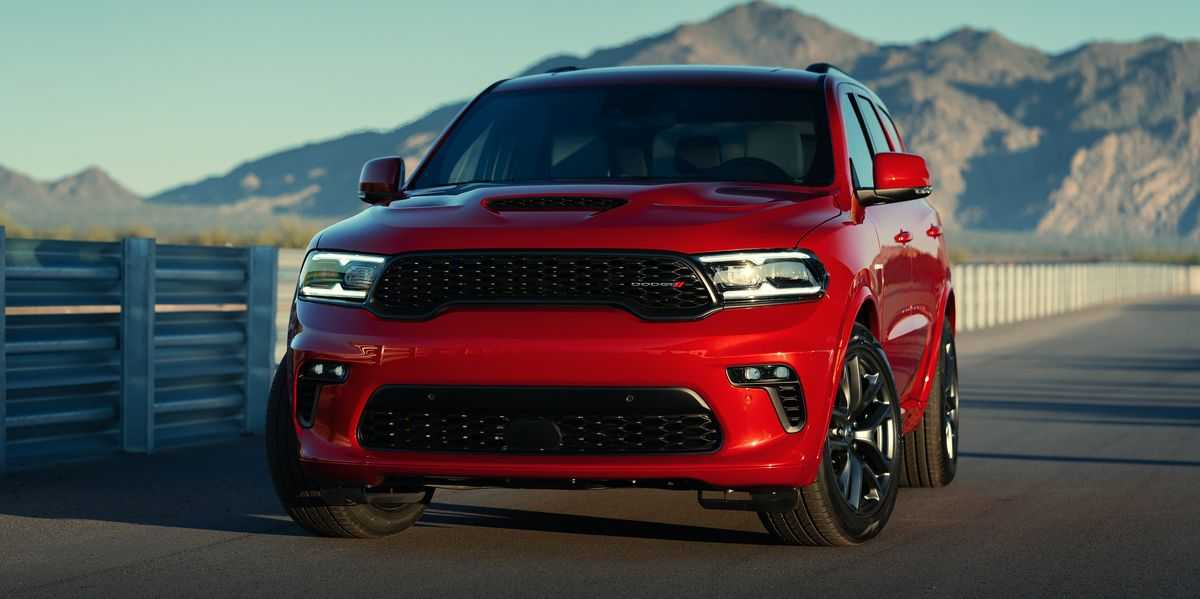Dodge Durango 2022 Engine Overheat and Emergency User Manual
HAZARD WARNING FLASHERS
The Hazard Warning Flashers button is located on the instrument panel, below the radio.
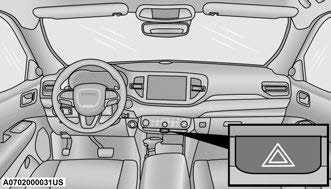
Hazard Warning Flashers Button
Push the button to turn on the Hazard Warning Flashers. When the button is activated, all directional turn signals will flash on and off to warn oncoming traffic of an emergency. Push the switch a second time to turn off the Hazard Warning Flashers.
This is an emergency warning system and it should not be used when the vehicle is in motion. Use it when your vehicle is disabled and it is creating a safety hazard for other motorists.
When you must leave the vehicle to seek assistance, the Hazard Warning Flashers will continue to operate even though the ignition is placed in the OFF position.
NOTE:
With extended use, the Hazard Warning Flashers may wear down your battery.
ASSIST AND SOS MIRROR — IF EQUIPPED

Assist And SOS Mirror
- SOS Button
- ASSIST Button
If equipped, the rearview mirror contains an ASSIST and a SOS button.
WARNING!
ALWAYS obey traffic laws and pay attention to the road. ALWAYS drive safely with your hands on the steering wheel. You have full responsibility and assume all risks related to the use of the Uconnect and SiriusXM Guardian™ features and applications in this vehicle. Only use Uconnect features and SiriusXM Guardian™ services when it is safe to do so. Failure to do so may result in an accident involving serious injury or death.
NOTE:
- Your vehicle may be transmitting data as authorized by the subscriber page 314.
- The SOS and ASSIST buttons will only function if you are connected to an operable LTE (voice/data) or 4G (data) network. Other Uconnect services will only be operable if your SiriusXM Guardian™ service is active and you are connected to an operable LTE (voice/data) or 4G (data) network.
ASSIST Call
The ASSIST Button is used to automatically connect you to any one of the following support centers:
- Roadside Assistance – If you get a flat tire, or need a tow, just push the ASSIST button and you will be connected to a representative for assistance. Roadside Assistance will know what vehicle you’re driving and its location. Additional fees may apply for roadside Assistance.
- SiriusXM Guardian™ Customer Care – In-vehicle support for SiriusXM Guardian™.
- Vehicle Customer Care – Total support for all other vehicle issues.
- Uconnect Customer Care – Total support for Radio, Phone and NAV issues.
SOS Call
- Push the SOS Call button on the Rearview Mirror.
NOTE:
In case the SOS Call button is pushed in error, there will be a 10 second delay before the SOS Call system initiates a call to a SOS operator. To cancel the SOS Call connection, push the SOS call button on the Rearview Mirror or press the cancellation button on the Device Screen. Termination of the SOS Call will turn off the green LED light on the Rearview Mirror. - The LED light located between the ASSIST and SOS buttons on the Rearview Mirror will turn green once a connection to a SOS operator has been made.
- Once a connection between the vehicle and a SOS operator is made, the SOS Call system may transmit the following important vehicle information to a SOS operator:
- Indication that the occupant placed a SOS Call.
- The vehicle brand.
- The last known GPS coordinates of the vehicle.
- You should be able to speak with the SOS operator through the vehicle audio system to determine if additional help is needed.
WARNING!
ALWAYS obey traffic laws and pay attention to the road. ALWAYS drive safely with your hands on the steering wheel. You have full responsibility and assume all risks related to the use of the Uconnect and SiriusXM Guardian™ features and applications in this vehicle. Only use Uconnect features and SiriusXM Guardian™ services when it is safe to do so. Failure to do so may result in an accident involving serious injury or death.
NOTE:
- Your vehicle may be transmitting data as authorized by the subscriber.
- Once a connection is made between the vehicle’s SOS Call system and the SOS operator, the SOS operator may be able to open a voice connection with the vehicle to deter-mine if additional help is needed. Once the SOS operator opens a voice connection with the vehicle’s SOS Call system, the operator should be able to speak with you or other vehicle occupants and hear sounds occur-ring in the vehicle. The vehicle’s SOS Call system will attempt to remain connected with the SOS operator until the SOS operator terminates the connection.
- The SOS operator may attempt to contact appropriate emergency responders and provide them with important vehicle information and GPS coordinates.
WARNING!
- If anyone in the vehicle could be in danger (e.g., fire or smoke is visible, dangerous road conditions or location), do not wait for voice contact from an Emergency Services Agent. All occupants should exit the vehicle immediately and move to a safe location.
- Never place anything on or near the vehicle’s operable network and GPS antennas. You could prevent operable network and GPS signal reception, which can prevent your vehicle from placing an emergency call. An operable network and GPS signal reception is required for the SOS Call system to function properly.
- The SOS Call system is embedded into the vehicle’s electrical system. Do not add after-market electrical equipment to the vehicle’s electrical system. This may prevent your vehicle from sending a signal to initiate an emergency call. To avoid interference that can cause the SOS Call system to fail, never add aftermarket equipment (e.g., two-way mobile radio, CB radio, data recorder, etc.) to your vehicle’s electrical system or modify the antennas on your vehicle. IF YOUR VEHICLE LOSES BATTERY POWER FOR ANY REASON (INCLUDING DURING OR AFTER AN ACCI-DENT), THE UCONNECT FEATURES, APPS AND SERVICES, AMONG OTHERS, WILL NOT OPERATE.
- Modifications to any part of the SOS Call system could cause the air bag system to fail when you need it. You could be injured if the air bag system is not there to help protect you.
SOS Call System Limitations
Vehicles sold in Mexico DO NOT have SOS Call system capabilities.
SOS or other emergency line operators in Mexico may not answer or respond to SOS system calls.
If the SOS Call system detects a malfunction, any of the following may occur at the time the malfunction is detected, and at the beginning of each ignition cycle:
- The Rearview Mirror light located between the ASSIST and SOS buttons will continuously illuminate red.
- The Device Screen will display the following message “Vehicle device requires service”. Please contact an authorized dealer.
- An In-Vehicle Audio message will state “Vehicle device requires service”. Please contact an authorized dealer.
WARNING!
- Ignoring the Rearview Mirror light could mean you will not have SOS Call services. If the Rear-view Mirror light is illuminated, have an authorized dealer service the SOS Call system immediately.
- The Occupant Restraint Control module turns on the air bag Warning Light on the instrument panel if a malfunction in any part of the system is detected. If the Air Bag Warning Light is illuminated, have an authorized dealer service the Occupant Restraint Control system immediately.
Even if the SOS Call system is fully functional, factors beyond FCA US LLC’s control may prevent or stop the SOS Call system operation. These include, but are not limited to, the following factors:
- The ignition is in the OFF position.
- The vehicle’s electrical systems are not intact.
- The SOS Call system software and/or hardware are damaged during a crash.
- The vehicle battery loses power or becomes disconnected during a vehicle crash.
- LTE (voice/data) or 4G (data) network and/or Global Positioning Satellite signals are unavailable or obstructed.
- Equipment malfunction at the SOS operator facility.
- Operator error by the SOS operator.
- LTE (voice/data) or 4G (data) network congestion.
- Weather.
- Buildings, structures, geographic terrain, or tunnels.
WARNING!
ALWAYS obey traffic laws and pay attention to the road. ALWAYS drive safely with your hands on the steering wheel. You have full responsibility and assume all risks related to the use of the Uconnect and SiriusXM Guardian™ features and applications in this vehicle. Only use Uconnect features and SiriusXM Guardian™ services when it is safe to do so. Failure to do so may result in an accident involving serious injury or death.
NOTE:
- Your vehicle may be transmitting data as authorized by the subscriber.
- Never place anything on or near the vehicle’s LTE (voice/data) or 4G (data) and GPS antennas. You could prevent LTE (voice/data) or 4G (data) and GPS signal reception, which can prevent your vehicle from placing an emergency call. An operable LTE (voice/data) or 4G (data) network connection and a GPS signal is required for the SOS Call system to function properly.
NOTE:
Changes or modifications not expressly approved by the party responsible for compliance could void the user’s authority to operate the equipment.
CAUTION!
To avoid damage to the mirror during cleaning, never spray any cleaning solution directly onto the mirror. Apply the solution onto a clean cloth and wipe the mirror clean.
Automatic SOS — If Equipped
Automatic SOS is a hands-free safety service that can immediately connect you with help in the event that your vehicle’s airbags deploy. Please refer to your provided radio supplement for complete information.
JACKING AND TIRE CHANGING
WARNING!
- Do not attempt to change a tire on the side of the vehicle close to moving traffic. Pull far enough off the road to avoid the danger of being hit when operating the jack or changing the wheel.
- Being under a jacked-up vehicle is dangerous. The vehicle could slip off the jack and fall on you. You could be crushed. Never put any part of your body under a vehicle that is on a jack. If you need to get under a raised vehicle, take it to a service center where it can be raised on a lift.
- Never start or run the engine while the vehicle is on a jack.
- The jack is designed to be used as a tool for changing tires only. The jack should not be used to lift the vehicle for service purposes. The vehicle should be jacked on a firm level surface only. Avoid ice or slippery areas.
PREPARATIONS FOR JACKING
- Park the vehicle on a firm, level surface as far from the edge of the roadway as possible. Avoid icy or slippery areas.
WARNING!
Do not attempt to change a tire on the side of the vehicle close to moving traffic, pull far enough off the road to avoid being hit when operating the jack or changing the wheel. - Turn on the Hazard Warning Flashers.
- Apply the parking brake.
- Place the gear selector into PARK (automatic transmission) or FIRST gear (manual transmission).
- Turn the ignition OFF.
- Block both the front and rear of the wheel diagonally opposite the jacking position. For example, if the driver’s front wheel is being changed, block the passenger’s rear wheel.
![Dodge Challenger 2022-2023 InCase of Emergency User Manual 3]](https://autouserguide.com/wp-content/uploads/2023/04/Dodge-Challenger-2022-2023-InCase-of-Emergency-User-Manual-3.jpg)
Wheel Blocked
NOTE:
Passengers should not remain in the vehicle when the vehicle is being lifted or raised.
JACK LOCATION
The scissor-type jack and tire changing tools are located in rear cargo area, below the load floor.

Load Floor Handle
Lift up on the load floor handle to access the jack and tools in the cargo area.

Jack And Tools Storage Cover
To remove, press down firmly on the upper tabs of the jack storage cover to release.
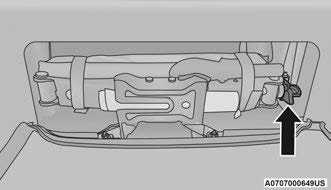
Thumb Screw Location
Rotate the plastic thumb screw on the end of the jack to loosen the jack and remove from the bracket.

Jack Removal
SPARE TIRE STOWAGE
The spare tire is stowed under the rear of the vehicle by means of a cable winch mechanism. To remove or stow the spare, use the jack handle/lug wrench connected to the square socket extension to rotate the “spare tire drive” nut. The nut is located under a plastic cover at the center-rear of the cargo floor area, just inside the liftgate opening.

Spare Tire Location
CAUTION!
The winch mechanism is designed for use with the jack wrench extension tool only. Use of air wrench or power tool may damage the winch.
SPARE TIRE REMOVAL
Remove the spare tire before attempting to jack up the vehicle. The spare tire is stowed underneath the rear cargo area on the outside of the vehicle.
For spare tire removal, follow the steps below:
- Remove the jack tools from the bag.
- Raise the rubber mat and remove the plug from storage compartment floor.
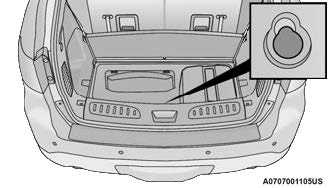
Winch Plug Location - Fit the jack handle extension over the drive nut. Use the lug wrench handle and extension to completely lower the spare tire. Keep turning the handle counterclockwise until the winch stops.
CAUTION!
The winch mechanism is designed for use with the jack wrench extension tool only. Use of air wrench or power tool may damage the winch.
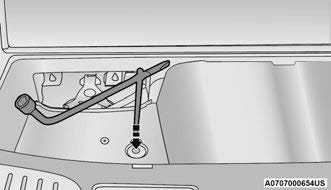
Winch Location
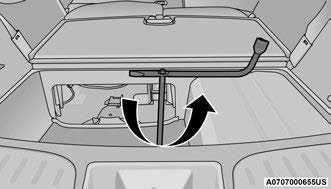
Wrench Rotation
- Slide the tire out from under the vehicle and rotate it vertically behind the rear fascia/bumper.
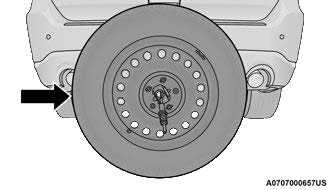
Spare Tire
NOTE:
Depending on the vehicle trim, the vehicle may come equipped with both, a metal retainer and plastic plate or a metal retainer only when removing the spare page 296. - Pull the metal stamping toward you to release it from the plastic plate (if equipped).
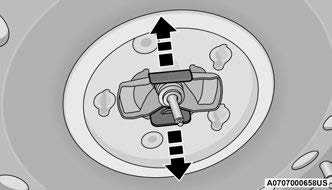
Spare Tire Retainer - Slide the metal stamping up the steel extension tube and winch cable. Rotate the metal stamping and push it through the hole in the plastic plate (if applicable) and wheel.

Sleeve And Cable - If your vehicle is equipped with a spare tire retainer and plastic plate. Pinch the three short and two long tubes to remove the protective plate from the steel spare wheel.
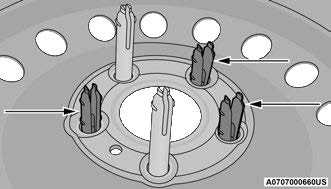
Releasing Protective Plate
JACKING INSTRUCTIONS
WARNING!
Carefully follow these tire changing warnings to help prevent personal injury or damage to your vehicle:
- Always park on a firm, level surface as far from the edge of the roadway as possible before raising the vehicle.
- Turn on the Hazard Warning Flashers.
- Apply the parking brake firmly and set the transmission in PARK.
- Block the wheel diagonally opposite the wheel to be raised.
- Never start or run the engine with the vehicle on a jack.
- Do not let anyone sit in the vehicle when it is on a jack.
- Do not get under the vehicle when it is on a jack. If you need to get under a raised vehicle, take it to a service center where it can be raised on a lift.
- Only use the jack in the positions indicated and for lifting this vehicle during a tire change.
- If working on or near a roadway, be extremely careful of motor traffic.
- To assure that spare tires, flat or inflated, are securely stowed, spares must be stowed with the valve stem facing the ground.

- Jack Warning Label
CAUTION!
Do not attempt to raise the vehicle by jacking on locations other than those indicated in the Jacking Instructions for this vehicle.
- Loosen (but do not remove) the wheel lug nuts by turning them to the left, one turn, while the wheel is still on the ground.
- Assemble the jack and jacking tools.

Jack And Tool Assembly
NOTE:
Placement for the front and rear jacking locations are critical. See below images for proper jacking locations.

Jacking Locations - For the front tire, place the jack on the body flange just behind the front tire. Do not raise the vehicle until you are sure the jack is fully engaged.

Front Lifting Point
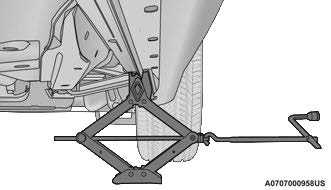
Front Jacking Location - For a rear tire, place the jack in the slot on the rear tie-down bracket, just forward of the rear tire. Do not raise the vehicle until you are sure the jack is fully engaged.

Rear Lifting Point

Rear Jacking Location - Raise the vehicle by turning the jack screw clockwise. Raise the vehicle just enough to remove the flat tire.
WARNING!
Raising the vehicle higher than necessary can make the vehicle less stable. It could slip off the jack and hurt someone near it. Raise the vehicle only enough to remove the tire. - Remove the lug nuts and wheel.
- Install the spare wheel/tire on the vehicle and install the lug nuts with the cone-shaped end toward the wheel. Lightly tighten the nuts.
WARNING!
To avoid the risk of forcing the vehicle off the jack, do not tighten the wheel nuts fully until the vehicle has been lowered. Failure to follow this warning may result in serious injury.

Mounting Spare Tire
CAUTION!
Be sure to mount the spare tire with the valve stem facing outward. The vehicle could be damaged if the spare tire is mounted incorrectly. - Lower the vehicle by turning the jack screw counterclockwise, and remove the jack and wheel blocks.
- Finish tightening the wheel bolts. Push down on the wrench while at the end of the handle for increased leverage. Tighten the wheel bolts in a star pattern until each wheel bolt has been tightened twice. If in doubt about the correct tightness, have them checked with a torque wrench by an authorized dealer or at a service station page 305.
- Push out the small center cap using the jack tool from inside the aluminum road wheel and position the wheel behind the rear fascia/bumper with the protective plate facing outward.
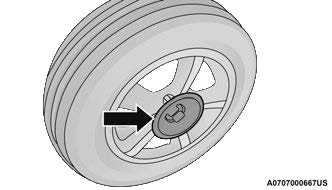
Installing Protective Plate On Damaged Wheel
NOTE:
The plastic plate will prevent the road wheel from being scratched when sliding it under the vehicle. - Insert the two long tubes on the plastic protective plate in the lug holes of the road wheel. Push the end of the winch’s cable, spring, steel sleeve and stamped cone shape wheel plate though the road wheel and protective plate.

Installing Winch - Slide the road wheel on the ground using the protective plate until it is directly under the winch and between the rear fascia/bumper and exhaust system heat shields. Raise the tire by turning the lug wrench on the winch extension clockwise until it clicks/ratchets three times to make sure the cable is tight.
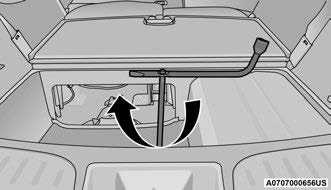
Wrench Rotation
NOTE:
Double check to ensure the tire is snug against the underbody of the vehicle. Damage to the winch cable may result if the vehicle is driven with the tire loose.
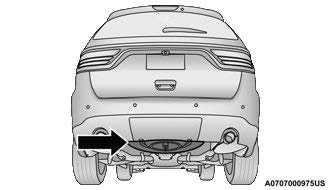
Road Wheel Installed In Spare Location
CAUTION!
The winch mechanism is designed for use with the jack wrench extension tool only. Use of air wrench or power tool may damage the winch. - After 25 miles (40 km), check the lug nut torque with a torque wrench to ensure that all lug nuts are properly seated against the wheel.
- Lower the jack to the fully closed position. Return the tools to the proper positions in the tool bag. Fold the flap on the tool bag under the tools and roll the tools in the bag underneath the others. Use the hook and loop fasteners to secure the tool bag to the jack with the lug wrench on the forward side of the jack.
- Expand the jack on the bracket by turning the thumb screw clockwise until it is tight to prevent rattles.
Reinstall the plastic plug into the floor of the cargo area. Roll up and store the Jack, Tool Kit and Tire Changing Instructions. Reinstall the cover for the jack in the rear storage bin. - 16. Have the aluminum road wheel and tire repaired as soon as possible and properly secure the spare tire, jack and tool kit.
WARNING!
A loose tire or jack thrown forward in a collision or hard stop, could endanger the occupants of the vehicle. Always stow the jack parts and the spare tire in the places provided.
JUMP STARTING
If your vehicle has a discharged battery, it can be jump started using a set of jumper cables and a battery in another vehicle, or by using a portable battery booster pack. Jump starting can be dangerous if done improperly, so please follow the procedures in this section carefully.
WARNING!
Do not attempt jump starting if the battery is frozen. It could rupture or explode and cause personal injury.
CAUTION!
Do not use a portable battery booster pack or any other booster source with a system voltage greater than 12 Volts or damage to the battery, starter motor, alternator or electrical system may occur.
NOTE:
When using a portable battery booster pack, follow the manufacturer’s operating instructions and precautions.
PREPARATIONS FOR JUMP START
The battery is stored under an access cover in the trunk. Remote battery posts are located on the right side of the engine compartment for jump starting.
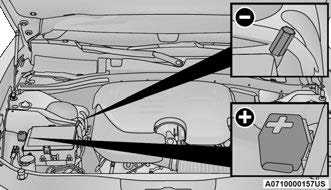
Remote Jump Starting Post Locations
- Remote Positive (+) Post (Covered With Protective Cap)
- Remote Negative (-) Post (Covered With Protective Cap)
NOTE:
Be sure that the disconnected cable ends do not touch each other, or either vehicle, before properly connected for jump starting.
See below steps to prepare for jump starting:
- Apply the parking brake, shift the automatic transmission into PARK (P) and turn the ignition OFF.
- Turn off the heater, radio, and all electrical accessories.
- Remove the protective cover over the remote positive (+) battery post. Pull upward on the cover to remove it.
- Remove the protective cover over the remote negative (-) battery post.
- If using another vehicle to jump start the battery, park the vehicle within the jumper cable’s reach, apply the parking brake and make sure the ignition is OFF.
WARNING!
- Do not allow vehicles to touch each other as this could establish a ground connection and personal injury could result.
- Take care to avoid the radiator cooling fan whenever the hood is raised. It can start anytime the ignition switch is ON. You can be injured by moving fan blades.
- Remove any metal jewelry such as rings, watch bands and bracelets that could make an inadvertent electrical contact. You could be seriously injured.
- Batteries contain sulfuric acid that can burn your skin or eyes and generate hydrogen gas which is flammable and explosive. Keep open flames or sparks away from the battery.
JUMP STARTING PROCEDURE
WARNING!
Failure to follow this jump starting procedure could result in personal injury or property damage due to battery explosion.
CAUTION!
Failure to follow these procedures could result in damage to the charging system of the booster vehicle or the discharged vehicle.
NOTE:
Make sure at all times that unused ends of jumper cables are not contacting each other or either vehicle while making connections.
Connecting The Jumper Cables
- Connect the positive (+) end of the jumper cable to the remote positive (+) post of the discharged vehicle.
- Connect the opposite end of the positive (+) jumper cable to the positive (+) post of the booster battery.
- Connect the negative (-) end of the jumper cable to the negative (-) post of the booster battery.
- Connect the opposite end of the negative (-) jumper cable to the remote negative (-) post (exposed metallic/unpainted post of the discharge vehicle) located on the right hand side next to the underhold fuse box.
WARNING!
Do not connect the jumper cable to the negative (-) post of the discharged battery. The resulting electrical spark could cause the battery to explode and could result in personal injury. - Start the engine in the vehicle that has the booster battery, let the engine idle a few minutes, and then start the engine in the vehicle with the discharged battery.
CAUTION!
Do not run the booster vehicle engine above 2,000 RPM since it provides no charging benefit, wastes fuel, and can damage booster vehicle engine. - Once the engine is started, follow the disconnecting procedure below.
Disconnecting The Jumper Cables
- Disconnect the negative (-) end of the jumper cable from the remote negative (-) post of the vehicle with the discharged battery.
- Disconnect the opposite end of the negative (-) jumper cable from the negative (-) post of the booster battery.
- Disconnect the positive (+) end of the jumper cable from the positive (+) post of the booster battery.
- Disconnect the opposite end of the positive (+) jumper cable from the remote positive (+) post of the vehicle with the discharged battery, and reinstall the protective cap.
If frequent jump starting is required to start your vehicle you should have the battery and charging system inspected at an authorized dealer.
CAUTION!
Accessories plugged into the vehicle power outlets draw power from the vehicle’s battery, even when not in use (i.e., cellular devices, etc.). Eventually, if plugged in long enough without engine operation, the vehicle’s battery will discharge sufficiently to degrade battery life and/or prevent the engine from starting.
REFUELING IN EMERGENCY – IF EQUIPPED
The vehicle is equipped with a refueling funnel for a Cap-Less Fuel System. The fuel funnel can be found in the rear cargo area with the jack and tools. If refueling is necessary, while using an approved gas can, insert the refueling funnel into the filler neck opening. Take care to open both flappers with the funnel to avoid spills.
WARNING!
- Never have any smoking materials lit in or near the vehicle when the fuel door is open or the tank is being filled.
- Never add fuel when the engine is running. This is in violation of most state and federal fire regulations and may cause the Malfunc-tion Indicator Light to turn on.
- A fire may result if fuel is pumped into a portable container that is inside of a vehicle. You could be burned. Always place fuel containers on the ground while filling.
NOTE:
In certain cold conditions, ice may prevent the fuel door from opening. If this occurs, lightly push on the fuel door to break the ice buildup and
re-release the fuel door using the inside release button. Do not pry on the door.
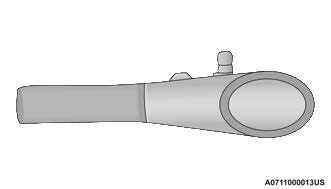
Refueling Funnel
Emergency Gas Can Refueling
Most gas cans will not open the flapper doors. A funnel is provided to allow emergency refueling with a gas can.
See below steps for refueling:
- Retrieve funnel from the rear cargo storage area.
 Refueling Funnel Location
Refueling Funnel Location- Insert funnel into same filler pipe opening as the fuel nozzle.

Inserting Funnel - Ensure funnel is inserted fully to hold flapper doors open.
- Pour fuel into funnel opening.
CAUTION!
To avoid fuel spillage and overfilling, do not “top off” the fuel tank after filling. - Remove funnel from filler pipe, clean off prior to putting back in the spare tire storage area.
IF YOUR ENGINE OVERHEATS
If the vehicle is overheating, it will need to be serviced by an authorized dealer.
In any of the following situations, you can reduce the potential for overheating by taking the appropriate action.
- On the highways — slow down.
- In city traffic — while stopped, place the trans-mission in NEUTRAL (N), but do not increase the engine idle speed while preventing vehicle motion with the brakes.
NOTE:
There are steps that you can take to slow down an impending overheat condition:
- If your Air Conditioner (A/C) is on, turn it off. The A/C system adds heat to the engine cooling system and turning the A/C off can help remove this heat.
- You can also turn the temperature control to maximum heat, the mode control to floor and the blower control to high. This allows the heater core to act as a supplement to the radiator and aids in removing heat from the engine cooling system.
WARNING!
You or others can be badly burned by hot engine coolant (antifreeze) or steam from your radiator. If you see or hear steam coming from under the hood, do not open the hood until the radiator has had time to cool. Never try to open a cooling system pressure cap when the radiator or coolant bottle is hot.
CAUTION!
Driving with a hot cooling system could damage your vehicle. If the temperature gauge reads HOT (H), pull over and stop the vehicle. Idle the vehicle with the air conditioner turned off until the pointer drops back into the normal range. If the pointer remains on HOT (H), and you hear continuous chimes, turn the engine off immediately and call for service.
MANUAL PARK RELEASE — 8–SPEED TRANSMISSION
WARNING!
Always secure your vehicle by fully applying the parking brake before activating the Manual Park Release. In addition, you should be seated in the driver’s seat with your foot firmly on the brake pedal when activating the Manual Park Release. Activating the Manual Park Release will allow your vehicle to roll away if it is not secured by the parking brake, or by proper connection to a tow vehicle. Activating the Manual Park Release on an unsecured vehicle could lead to serious injury or death for those in or around the vehicle.
In order to move the vehicle in cases where the transmission will not shift out of PARK (P) (such as a depleted battery), a Manual Park Release is available.
Follow these steps to use the Manual Park Release:
- Firmly apply the parking brake.
Open the center console and locate the Manual Park Release cover, remove it by snapping the cover away from the console hinges. 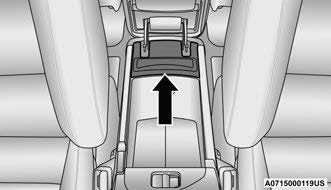 Manual Park Release Cover
Manual Park Release Cover
NOTE:
Depending on your vehicle’s trim level, the Manual Park Release cable may be located in a different area on the center console.- Press and maintain firm pressure on the brake pedal.
- Using a screwdriver or similar tool, push the metal latch in towards the tether strap.
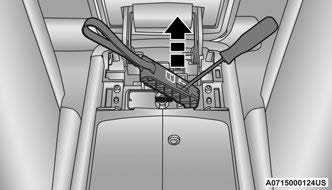 Release Latch
Release Latch - While the metal latch is in the open position, pull upward on the tether strap until the lever clicks and latches in the released position. The transmission is now out of PARK (P) and the vehicle can be moved.

Released Position
CAUTION!
Closing the armrest while the Manual Park Release is activated may damage the Manual Park Release mechanism, the transmission, and/or the armrest.
NOTE:
To prevent the vehicle from rolling unintentionally, firmly apply the parking brake.
To Disengage The Manual Park Release Lever:
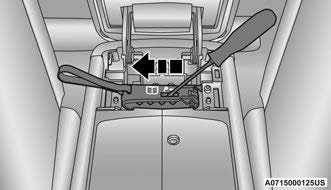
Release Latch
- Once the tension has been released and the lever has been unlocked, be sure it is stowed properly and locks into position.

Stowed Position
NOTE:
Be sure to replace the cover by snapping it back in place.
FREEING A STUCK VEHICLE
If your vehicle becomes stuck in mud, sand, or snow, it can often be moved using a rocking motion. Turn the steering wheel right and left to clear the area around the front wheels. For vehicles with automatic transmission, push and hold the lock button on the gear selector. Then shift back and forth between DRIVE and REVERSE (with automatic transmission) or FIRST gear and REVERSE (with manual transmission), while gently pressing the accelerator. Use the least amount of accelerator pedal pressure that will maintain the rocking motion, without spinning the wheels or racing the engine.
NOTE:
Shifts between DRIVE (D) and REVERSE (R) can only be achieved at wheel speeds of 5 mph (8 km/h) or less. Whenever the transmission remains in NEUTRAL (N) for more than two seconds, you must press the brake pedal to engage DRIVE (D) or REVERSE (R).
Use the least amount of accelerator pedal pressure that will maintain the rocking motion without spinning the wheels or racing the engine.
NOTE:
Push the ESC OFF button to place the Electronic Stability Control (ESC) system in “Partial OFF” mode, before rocking the vehicle Ú page 189. Once the vehicle has been freed, push the ESC OFF button again to restore ESC On mode.
WARNING!
Fast spinning tires can be dangerous. Forces generated by excessive wheel speeds may cause damage, or even failure, of the axle and tires. A tire could explode and injure someone. Do not spin your vehicle’s wheels faster than 30 mph (48 km/h) or for longer than 30 seconds continuously without stopping when you are stuck and do not let anyone near a spinning wheel, no matter what the speed.
CAUTION!
- Racing the engine or spinning the wheels may lead to transmission overheating and failure. Allow the engine to idle with the transmission in NEUTRAL for at least one minute after every five rocking-motion cycles. This will minimize overheating and reduce the risk of transmis-sion failure during prolonged efforts to free a stuck vehicle.
- When “rocking” a stuck vehicle by shifting between DRIVE / FIRST gear and REVERSE, do not spin the wheels faster than 15 mph (24 km/h), or drivetrain damage may result.
- Revving the engine or spinning the wheels too fast may lead to transmission overheating and failure. It can also damage the tires. Do not spin the wheels above 30 mph (48 km/h) while in gear (no transmission shifting occur-ring).
TOWING A DISABLED VEHICLE
This section describes procedures for towing a disabled vehicle using a commercial towing service.
If the transmission and drivetrain are operable, disabled 4×4 vehicles may also be towed as described under page 147.
| Towing Condition | Wheels OFF The Ground | Rear-Wheel Drive Models | All-Wheel Drive Models With Single-Speed Transfer Case | All-Wheel Drive Models With Two-Speed Transfer Case |
|
Flat Tow |
NONE |
NOT ALLOWED |
NOT ALLOWED |
Detailed Instructions
l Transmission in PARK l Transfer case in NEUTRAL (N) l Tow in forward direction |
| Wheel Lift Or Dolly Tow | Front | NOT ALLOWED | NOT ALLOWED | NOT ALLOWED |
| Rear | OK | NOT ALLOWED | NOT ALLOWED | |
| Flatbed | ALL | BEST METHOD | OK | BEST METHOD |
| NOTE:
When towing your vehicle, always follow applicable state and provincial laws. Contact state and provincial Highway Safety offices for additional details. |
||||
Proper towing or lifting equipment is required to prevent damage to your vehicle. Use only tow bars and other equipment designed for this purpose, following equipment manufacturer’s instructions. Use of safety chains is mandatory. Attach a tow bar or other towing device to main structural members of the vehicle, not to fascia/bumpers or associated brackets. State and local laws regarding vehicles under tow must be observed.
If you must use the accessories (wipers, defrosters, etc.) while being towed, the ignition must be in the ON/RUN mode, not the ACC mode. If the key fob is unavailable or the vehicle’s battery is discharged, find Instructions on shifting the transmission out of PARK page 251.
CAUTION!
- Do not use sling type equipment when towing. Vehicle damage may occur.
- When securing the vehicle to a flat bed truck, do not attach to front or rear suspension components. Damage to your vehicle may result from improper towing.
- FCA US LLC does not recommend towing this vehicle using a tow dolly. Vehicle damage may occur.
REAR-WHEEL DRIVE (RWD) MODELS
FCA US LLC recommends towing your vehicle with all four wheels OFF the ground using a flatbed.
If flatbed equipment is not available, and the transmission is operable, the vehicle may be flat towed (with all four wheels on the ground) under the following conditions:
- The transmission must be in NEUTRAL (N). Instructions on shifting the transmission to NEUTRAL (N) when the engine is off page 251.
- The towing distance must not exceed 30 miles (48 km).
- The towing speed must not exceed 30 mph (48 km/h).
CAUTION!
Towing faster than 30 mph (48 km/h) or farther than 30 miles (48 km) with rear wheels on the ground can cause severe transmission damage. Damage from improper towing is not covered under the New Vehicle Limited Warranty.
If the transmission is not operable, or the vehicle must be towed faster than 30 mph (48 km/h) or farther than 30 miles (48 km), tow with the rear wheels OFF the ground. Acceptable methods are to tow the vehicle on a flatbed, or with the front wheels raised and the rear wheels on a towing dolly, or (when using a suitable steering wheel stabilizer to hold the front wheels in the straight position) with the rear wheels raised and the front wheels ON the ground.
ALL WHEEL DRIVE MODELS
FCA US LLC recommends towing with all wheels OFF the ground. Acceptable methods are to tow the vehicle on a flatbed or with one end of the vehicle raised and the opposite end on a towing dolly.
If flatbed equipment is not available, and the transfer case is operable, vehicles with a two-speed transfer case may be towed (in the forward direction, with ALL wheels on the ground), IF the transfer case is in NEUTRAL (N) and the transmission is in PARK page 147.
Vehicles equipped with a single-speed transfer case have no NEUTRAL (N) position, and therefore must be towed will all four wheels OFF the ground.
CAUTION!
Front or rear wheel lifts must not be used (if the remaining wheels are on the ground). Internal damage to the transmission or transfer case will occur if a front or rear wheel lift is used when towing.
Towing this vehicle in violation of the above requirements can cause severe transmission and/or transfer case damage. Damage from improper towing is not covered under the New Vehicle Limited Warranty.
ENHANCED ACCIDENT RESPONSE SYSTEM (EARS)
This vehicle is equipped with an Enhanced Accident Response System.
This feature is a communication network that takes effect in the event of an impact page 218.
EVENT DATA RECORDER (EDR)
This vehicle is equipped with an event data recorder (EDR). The main purpose of an EDR is to record data that will assist in understanding how a vehicle’s systems performed under certain crash or near crash-like situations, such as an air bag deployment or hitting a road obstacle page 220.
2023 DODGE DURANGO Specs, Price, Features, Mileage (Brochure)
Reference Link
View Full PDF: Dodge Durango 2022 User Manual | Auto User Guide
Download Link: Owner’s Manuals & User Guides | Dodge

